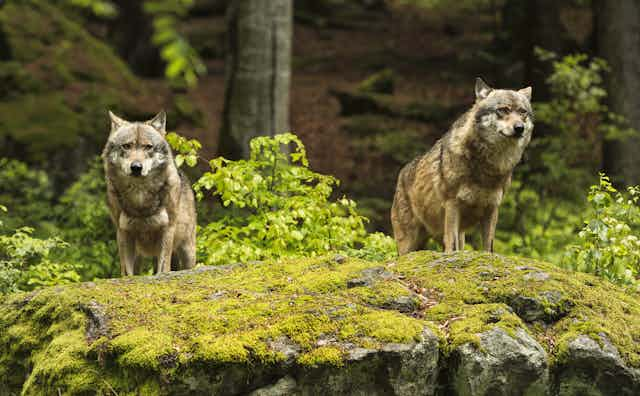Wolves are making a comeback across Europe. As their populations grow, 65,000 livestock are killed each year by wolves. Now, moves are underway to change the protection status of the wolf in the European Union.
In this episode of The Conversation Weekly, we speak to a social scientist researching the best ways for humans and wolves to coexist.
Wolves used to be commonplace across Europe until they were eradicated from large areas of the continent in the 19th century. But wolf populations began to recover in the 1970s as they moved into tracts of unused farmland and stricter conservation regulations were introduced.
A new analysis from the European Commission put the number of wolves in the EU at 20,300 in 2023, up 81% from the estimated 11,193 living in the bloc in 2012.
Hanna Pettersson is a social scientist at the University of York in the UK whose research focuses on how people react to living alongside wolves. She says Europe has essentially “outsourced all the biodiversity conservation” to other continents such as Africa or Asia.
It’s definitely our turn to take some responsibility when it comes to conservation. But it’s somewhat tricky to live with these large carnivores.
Pettersson’s PhD research focused on Spain, where hunting of wolves has been strictly prohibited since 2021. She interviewed people in different areas of the country to understand more about the interactions between wolves and humans and the best methods for living together.
For example, in one area called Sanabria-La Carballeda where farmers have always had to deal with wolves, they deploy packs of livestock guardian dogs to guard their animals. “People dedicate significant resources and efforts and time to protect their livestock from wolves – and they do so quite successfully,” explained Pettersson.
Read more: Wolf protection in Europe has become deeply political – Spain's experience tells us why
Wolves have made such a comeback in Europe that politicians are now moving to change their protection status. In September 2023, Ursula von de Leyen, president of the European Commission, said that the concentration of wolf packs in some European regions has become a “real danger for livestock and potentially also for humans”.
The Commission ran a call for information on wolf populations across the EU and in late December, proposed a change the protection status of wolves from “strictly protected” to “protected” under the Bern Convention, a treaty governing the conservation of wild flora and fauna across the EU. If that proposal is accepted, it will pave the way for a change to the European habitat directives to give countries more powers to control wolf populations.
To find out more about Pettersson’s research into the way communities can transition to living with wolves, listen to the full episode of The Conversation Weekly podcast.
This episode of The Conversation Weekly was written and produced by Katie Flood, with assistance from Mend Mariwany. Sound design was by Eloise Stevens, and our theme music is by Neeta Sarl. Gemma Ware is the executive producer.
You can find us on X, formerly known as Twitter @TC_Audio, on Instagram at theconversationdotcom or via email. You can also subscribe to The Conversation’s free daily email here.
Listen to The Conversation Weekly via any of the apps listed above, download it directly via our RSS feed or find out how else to listen here.

